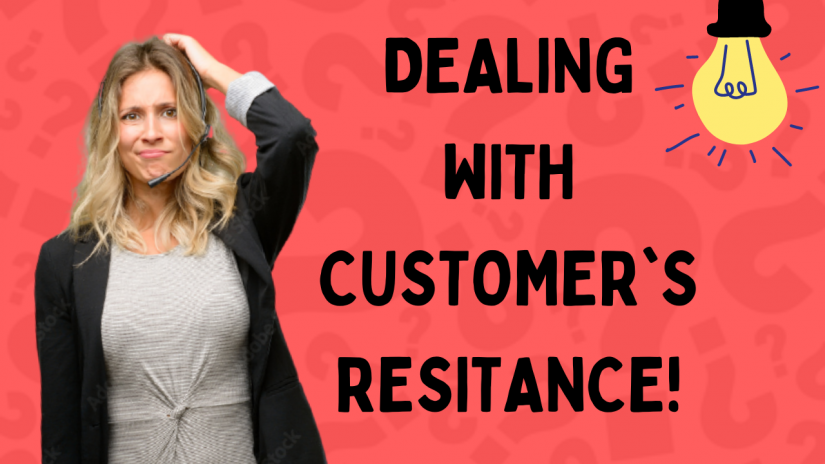The sales process is mainly the process of removing resistance. What is resistance? All questions, excuses, rejections, etc., of customers encountered during the sales process, are collectively referred to as sales resistance. When any customer buys a product, the resistance he produces is an event that will inevitably happen during the purchase process, which is normal. Sometimes it may also happen that a customer buys and he does not resist at all, but most of the time customers put resistance in front of the salesperson and it is their task to handle it. Whether the customer buys the products or not is then dependent on how well the salesman deals with their resistance, removes it and makes them feel positive about the product. Let’s discuss some of the most common types of resistance that customers put in front of salesmen and learn ways of dealing with them.
Table of Contents
- 1. Critical Resistance
- 2. Silent Resistance
- 3. Excuse Resistance
- 4. Sceptical Resistance
- 5. Show Off Resistance
- 6. Problem Based Resistance
- 7. Subjective Resistance
- Final Words
1. Critical Resistance
Sometimes customers will make some negative criticisms of your products and services, your company, or even you. They will criticize the quality of your products and may criticize the price of your products. When encountering this kind of critical resistance, the first thing you need to do is to remember not to dispute with your client, do not criticize him, be on the front line with him, and you must understand him, Respect him. Next, to deal with this type of resistance you need to have a good knowledge of your product, all its features, the needs that it satisfies, its shortcomings, if any, its competitors, advantages of competitor’s products over your product and advantages of your products over competitor’s products and so on. The more detailed knowledge you have, the better the position you will be in to tackle these types of resistances.
2. Silent Resistance

While contacting you, some customers will behave rather indifferently and don’t speak too much. They will just sit there calmly. What you need to do in this case is to find a way to make such customers talk more and ask them more questions. Because the more silent they are, the more difficulty you will have in bringing up their buying interest and willingness, so let them talk more. You have to ask them some open-ended questions. What is an open-ended question? A question that is easy to answer and let the customer speak their heart. It would help if you guided them to talk more about their own views on your products and their views on their own needs. As long as you can get them to talk more, it will be easier to focus their interest on yourself and your products. The manner in which they answer your questions will help you get an idea of their interest, likes and dislikes and based on that you can gradually guide the conversation towards your main objectives.
3. Excuse Resistance
Often customers resist as soon as the salesman puts a product forward, and those with experience know that it is an excuse. He knows that this is not the reason why customers really don’t buy. The excuses are just perfunctory. For example, “You are too expensive, I am not interested.” “I don’t have time; I need to think about it.” Experienced salesmen recognise an excuse when they hear it. So when you encounter this kind of resistance, you need to take the first step towards it, that is to ignore it. Then deal with it with good communication skills. For example, you can say, “I think the issues you mentioned are critical. I think that the price is a factor that everyone will take into account. So we can specifically discuss the price issues. Before discussing the price issue, I want to take a few minutes to tell you the advantages of our products, why we have had so many customers in the past who buy our products, and why you should probably consider buying from us instead of buying from others.” Take advantage of the flow of communication and introduce your products, services, and advantages.
Also read: 7 Types Of Customers And How To Sell Them
4. Sceptical Resistance

Customers don’t believe in your stuff. They doubt its utility, worth and value. You explain your products, their advantages and strengths to your customers, and they maintain a sceptical attitude. They don’t believe that your product will really bring them the benefits that you say. So what you need to do is to quickly prove why your product brings these benefits to him. You need to be convincing and put up some practical and insightful evidence in favour of your products. Your only way to deal with this type of resistance is to actually prove to the customer that your product is superior and you have to be ready to do whatever it takes.
5. Show Off Resistance
There are many customers who like to show off their professional knowledge in front of you. They like to let you know that they know your product very well like if they are more professional than you, showing that they are experts. Many salespersons will meet such customers. When dealing with this kind of client, you must remember to praise his professionalism, even if what he said is wrong.
6. Problem Based Resistance

Customers can sometimes ask a lot of questions. They may ask many questions that you think of or that you can’t think of. Every time a customer asks a question to test you, it means that the customer asks you for more information. If the customer does not ask any questions about your product, he may not be interested in your product at all, and he does not want to know your product’s content. He is asking questions, then that may be a good thing as he may be interested. So you have to be prepared for this. Of course, first of all, you must have sufficient knowledge and understanding of the products you are selling. Otherwise, the customers will ask you questions, and you may not know the answers to many of them. Then you will have no way to get rid of this resistance.
7. Subjective Resistance
Sometimes customers may simply be unsatisfied with you as a person. You can feel that the atmosphere between you and your customer is not quite right. It means that your affinity with the customer is too poor, or your behaviour didn’t strike that customer well. So what do you do this time? Maybe you talk too much about your own products, company, services, and things you care about. You may have too little time to focus on customers. So what you should do at this time is to quickly re-establish the affinity between you and the customer and win his favour and trust. At this time, you should talk less, ask more questions, listen more, and appreciate the customer’s views. Try to know more about the client from the way he talks and make changes to your behaviour accordingly.
Final Words
Showing resistance is a natural behaviour of customers. You may get lucky sometimes and find customers that readily accept your offer, but customers do exhibit resistant behaviour most of the time. Furthermore, success in sales is not because of luck but because of methods. Therefore you cannot depend on luck to favour you. Instead strive for learning at every moment and keep improving your methods. All the best!

